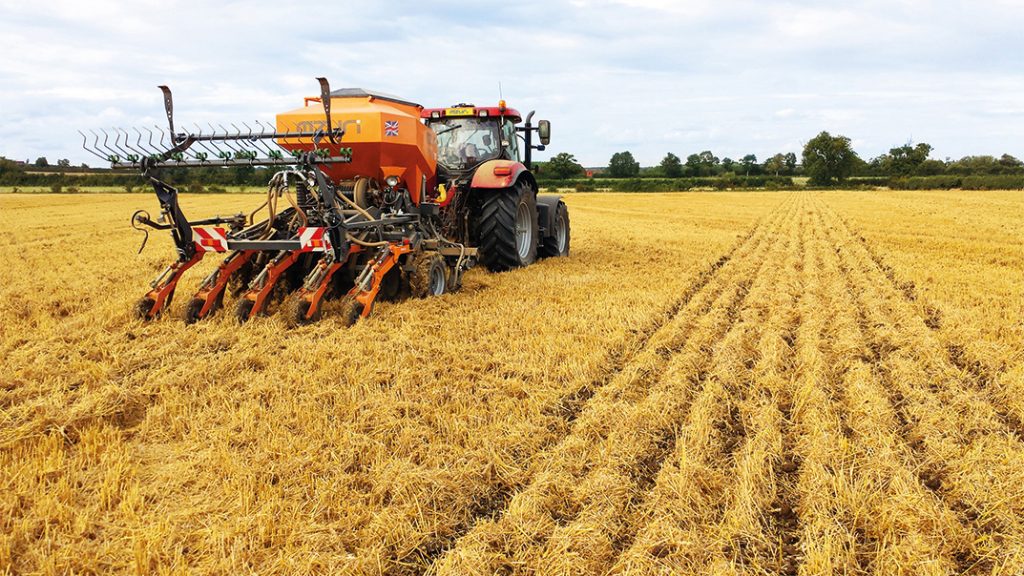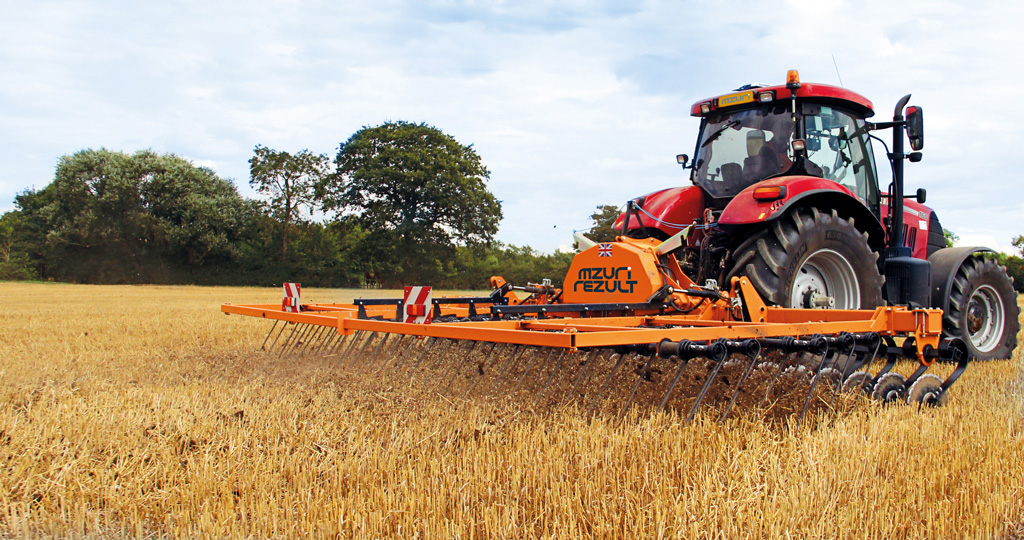With the growing challenges of profitable crop production, increasingly more progressive farmers are turning to the Mzuri strip tillage system to provide a sustainable solution. The Mzuri system is a conservational tillage technique where only a narrow strip of soil is cultivated to give the plant a head start whereas the remaining field remains untouched, allowing surface straw to break down naturally and retaining the moisture. This means that users can enjoy the benefits of both worlds – instant mineral availability and soil aeration typically associated with conventional inversion techniques and the soil preservation advantages attributed to zero tillage.
Not only does it aid crop establishment and improve soil structure, the Mzuri one-pass strip till system can considerably reduce cost and labour requirements. Fuel economies, lower capital investment and reduced maintenance costs ensure quick machine payback and return on investment. The system works with Nature utilising its natural resource – surface straw – turning trash into cash. Rather than being removed, previous crop residue and chaff are left in between the tilled strips and gradually recycled into valuable organic matter by earthworms. Uncultivated soil also benefits from improved structure, drainage and oxygen movement which ultimately contributes towards better nutrient uptake and increased yields. As well as making business sense, the Mzuri system is better for the environment: it can cut fertiliser by half as it is only placed where required, produce a healthier, more disease resistant crop and significantly lower carbon emissions.
How does it work?
A direct result of extensive research and development, Mzuri offers the Pro-Til range of strip till drills which prepare the soil and establish the crop in a single pass. For users looking to create a stale seedbed prior to drilling, the company also manufactures the Rezult straw rake.
Available in three, four and six metre working widths, the Pro-Til features a unique spring-loaded pivoting disc at the front which opens up the soil with minimum soil disturbance. The disc is followed by an auto-reset tine to gently cultivate the soil where a band of fertiliser can also be placed. Next, staggered wheels reconsolidate the tilled area, followed by ground-following coulter arms for perfect seed placement. The soil is once again reconsolidated by a press wheel for perfect seed to soil contact and levelled off by spring-loaded harrowing tines for an even soil finish.
The Pro-Til is now offered in the Select version which gives users a choice of 330mm or 660mm band spacings to suit the type of crop and to capitalise on light interception – a unique feature that allows to produce a healthier and stronger crop.
Points to consider when switching to strip tillage
There are a number of points to be considered in order to get the most out of strip tillage and the Mzuri equipment. Whilst the negative results of conventional cultivation such as poor soil structure, compaction, capping and waterlogging may take a little patience to reverse, here are a few tips that will get you underway towards the best results.
1. Correct strip tillage technique starts with the combine. “By failing to prepare, you are preparing to fail,” an old maxim which is also true for strip tillage. Good practice starts with preparing the perfect “canvas” to drill into and this means ensuring the field is “striptill-ready” at harvesting. Mzuri recommend the optimum stubble height of 150-250mm to ensure it flows well through the Pro-Til. An even distribution of chopped straw and chaff is also desirable as uniform mulching around the field will be paramount for ensuring good moisture retention and availability of material for earthworms to turn into nutrients.
2. To chit or not to chit? Although the Pro-Til can drill directly into surface straw in a one pass operation awarding excellent trash clearance, some farmers may prefer to create a stale seedbed prior to strip till drilling. This is particularly pertinent for farms with a blackgrass or slug problem or for users who wish to accelerate straw decomposition. Mzuri’s solution for this is the Rezult straw rake. It features a five-row tine harrow with the option to fit a set of leading discs. The result is a nice, light tilth creating the perfect stale seedbed.
3. Get the light right. Good light interception from early growth stages is key to strong plant structure and high yields. The stubble height of 150-250mm is ample enough to shield the crop from cold temperatures and winds yet short enough to ensure the plants get sufficient light. If left too long, the straw can fall onto the crop thus contaminating it and shielding it from precious sunlight. This can result in long and lanky plants and a crop that is more prone to disease.
4. Leave the surface straw… on the surface.Ideally, the crop residue should not be baled or taken away but left on the field. Let’s take a leaf out of Nature’s book who leaves last year’s growth to decompose naturally and turns it into valuable organic matter, thus vastly improving soil fertility and worm count. Not only that, the straw thatching acts as the perfect mulch and conserves moisture which would normally be lost through evaporation. It also prevents water and wind erosion.
5. Give the seed the best start. The secret to fast and successful seed germination is good seed to soil contact for instant availability of nutrients and moisture, soil reconsolidation to eliminate the air pockets and friable, fertile tilth to give the seed the best start. This is what the Mzuri Pro-Til does exceptionally well thanks to its combination of unique, patented features. The auto-reset tines produce the perfect tilth with the option of placing a band of fertiliser just where it is needed, followed by the reconsolidating wheel. The coulter tool bar works totally independently to the cultivation zone, ensuring easy adjustment and constant seed depth control. Each coulter hydraulically exerts pressure to each of the seed depth wheels to ensure accurate seed placement and excellent soil to seed contact. As a result, the crop can get away quickly and grow to achieve its full potential.
6. Understand your soil. One size does not fit all and so you should look to tailor the equipment to best suit your specific conditions. Mzuri offers a range of front leg options to easily adapt to any type of soil, including a choice of front discs and ripper leg configurations. The optional front leading discs cut through surface residue and help to create a tilth with minimum soil disturbance. The choice of the cultivation leg and wing tips control the tilth depth and profile. Wider wings are typically fitted for work in hard, sandy ground whereas narrow wings are best suited for peaty soil with high organic matter. Poorer, nutrient depleted soil can at this point be given a granular fertiliser boost.
7. Select the correct seeding coulter. Not only a host of options to tailor the soil, Mzuri offers a range of seeding coulters to suit the crop too. Wide band seeding is recommended for wheat and barley whereas narrow band seeding would be better suited for oilseed rape and beans.
8. The choice of wheels is also important to ensure the right amount of pressure is exerted. The Pro-Til can be supplied with a wide or narrow wheel profile to match the coulter and soil type. Dry soil conditions need slightly more pressure to ensure better seed to soil contact whereas drilling in wetter soils requires a lighter approach in order not to cap the soil.
9. The final touch. Pro-Til is supplied with a harrow bar which produces the perfect smooth finish for better coverage of pre-emergence herbicides. Other users prefer to keep the tilth profile untouched in order to create a microclimate which is 2-3°C warmer in the ridges – a practice which is particularly popular in colder climates with freezing winters. The slightly raised contours of the ground coupled with the surface straw each side of the crop row provide shelter from wind damage and the sub-zero temperatures. The practice ensures viable crop where conventionally drilled crop would often fail in the same conditions.
10. Rotation, rotation, rotation. At Mzuri, we promote a minimum 4-year rotation to increase crop health. The changing of crops in a sequence reduces their resistance to chemical, builds up plant resilience against disease and helps to combat persistent weeds.
Whilst strip tillage does not provide an instant solution, the benefits of the Mzuri system are apparent in as little as one year, with users consistently reporting visually improved soil structure, higher worm counts, improved yield per hectare and significant bottom line savings. It has to be noted that strip tillage is not just another drilling method but a crop management technique that calls for synchronicity with one’s land, understanding of its condition and the ability to respond to its needs. Armed with this knowledge, growers can only expect to see continued improvement with each year as the natural cycle is put into full swing. Finally, it seems, we have arrived at profitable farming without it actually costing the earth.










